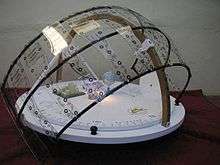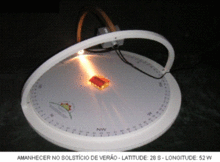Heliodon


A heliodon (HEE-leo-don) is a device for adjusting the angle between a flat surface and a beam of light to match the angle between a horizontal plane at a specific latitude and the solar beam. Heliodons are used primarily by architects and students of architecture. By placing a model building on the heliodon’s flat surface and making adjustments to the light/surface angle, the investigator can see how the building would look in the three-dimensional solar beam at various dates and times of day.
The Earth is a ball in space perpetually intercepting a cylinder of parallel energy rays from the sun. (Think of a tennis ball being held in the wind.) The angle of any earthly site to the solar beam is determined by
- The site’s latitude, which gives its position on the curve of the Earth between the Equator and one of the Poles.
- The time of day at the site, measured by its progress eastward around the Earth’s axis from sunrise to sunset.
- The date, which locates the Earth on its annual orbit of the sun.
The change due to date is the most difficult to visualize. The Earth’s axis is steady but tilted: the plane that includes the Earth’s equator, which is perpendicular to the axis, is not parallel to the plane that includes the center of the sun and the center of the Earth, called the ecliptic. Think of the Earth as a car on a Ferris wheel. The car’s axis always points “down”, which changes its relation to the center of the wheel. A light at the center of the wheel would touch the bottom of the car at the top of the orbit and the top of the car at the bottom of the orbit. As the Earth orbits, the location of the centerline of the solar cylinder changes, sliding from the Tropic of Cancer (in June) to the Tropic of Capricorn (in December) and back again. This changes sun angles all over Earth according to the date. See more at analemma.
Heliodons can mimic latitude, time of day, and date. They must also show a clear north-south direction on their surface in order to orient models. Some heliodons are very elaborate, using tracks in a high ceiling to carry a light across a large studio. Others are very simple, using a sundial as a guide to the adjustments and the sun of the day as a light source. In general, the date adjustment causes the most difficulty for the heliodon designer, while the light source presents the most problems in use. The parallel rays of the sun are not easy to duplicate with an artificial light at a useful scale, while the real sun is no respecter of deadlines or class hours.
All heliodons can benefit by including a moveable, tiltable device that can be set to match any surface on a model to show angle of incidence. The angle of incidence device indicates the relative intensity of the direct beam on the surface. The device consists of a diagram of concentric rings around a shadow-casting pointer perpendicular to the diagram. Each ring represents a percent of the direct solar beam incident on the surface. The percentage varies from 100%—the ray runs straight down the pointer perpendicular to the diagram—to zero—the ray runs parallel to the diagram and misses surface. The cosine of the angle of incidence gives the percentage. A cosine of 0.9, 90%, for example, corresponds to an angle of incidence of 26.84 degrees. The radius of the ring for the angle is equal to its tangent times the height of the shadow casting pointer. A 45 degree angle of incidence would generate a cosine of about .7, 70%, for example. Since the tangent of 45 degrees is 1, the radius of the 70% ring would be equal to the height of the shadow-casting rod.
External links
| Wikimedia Commons has media related to Heliodons. |